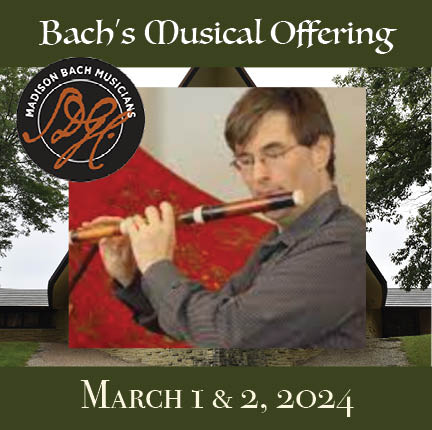
with Immanuel Davis, flute
First Unitarian Society Landmark Auditorium, Madison
Friday, March 1–7:15 pm lecture/8 pm concert
Saturday, March 2–12:45 pm lecture/1:30 pm concert
Towards the end of J. S. Bach’s lifetime, as musical taste shifted increasingly toward what we now call the gallant—music of manners—Bach found himself more and more interested in older, stricter, forms of contrapuntal writing, in particular canon techniques in which melodic imitation is inviolable. This puts the onus on the composer to devise material that is in itself compelling but which also lends itself to precise, imitative counterpoint—a very tall order.
In May of 1747, when 63 year-old Bach visited the opulent, au courant, and musically sophisticated Potsdam court of Frederick the Great—where Bach’s son Carl Philipp Emmanuel was principal keyboardist—Frederick asked Bach (challenged him, really!) to improvise upon a highly chromatic and contrapuntally recalcitrant tune which Frederick then provided. Bach, without hesitation, played an elegant and imaginative three-part fugue (ricercar) upon the theme—to the jaw-dropping astonishment of all present; many in the court ensemble were among the finest instrumentalists in Europe. Frederick, ever catty and unkind in the presence of true genius, quickly asked Bach if he could then improvise in SIX independent parts. Bach replied that it would be best if he could work it out on paper. The Musical Offering is what Bach composed for Frederick in the weeks immediately following. Based entirely on Frederick’s given theme, the work contains Bach’s initial ricercar, a dazzling array of canons—many of them in puzzle form, inversions, retrogressions, augmentations, etc.—a grand trio sonata, and the entire set concludes with the six-part ricercar that Frederick had attempted to taunt Bach with at their initial meeting.
MBM is thrilled to perform this consummate work of musical architecture in First Unitarian Society of Madison’s Landmark Meeting House, designed by Frank Lloyd Wright.
Immanuel Davis–FLUTE, Kangwon Kim & Nathan Giglierano–VIOLINS, James Waldo–CELLO, Trevor Stephenson–HARPSICHORD